|
3rd Battalion Royal Australian Regiment
Your FaithfullyJapan - Korea - Malaya - Borneo - Vietnam - East Timor - Solomons - Iraq - Afghanistan |
3rd Battalion Royal Australian Regiment 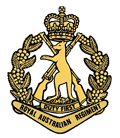 1st Tour Vietnam 1967 - 1968 |
|
The Tet Offensive in Ba Ria, Viet Nam 1968 |
|
(with recollections of Pte. David "Johnno" Johnston, 2Pl A Coy, 3RAR) |
|
Luke Johnston |
|
In January 1968, communist Vietnamese forces prepared to launch a major offensive against the Republic of Viet Nam and its supporters. The attacks were designed to coincide with the annual Lunar New Year (Tet) celebrations. The Tet celebration was traditionally a time of peace, and a cease fire had been negotiated for the holiday. However the offensive was designed to put an end to the resistance by the pro-democratic Free World Forces led by the Americans at a time when the guard was down. The communist North Vietnamese Army (NVA), Viet Cong (Viet Cong) and local town units launched attacks across southern Viet Nam in the early hours of the of February 1. 2Lt Peter Fraser's 2 platoon and Lt Harry Clarson's 3 platoon, with Major Howard's Company HQ were ordered to move at 7:35am. The young soldiers were told simply to get ready to move out. Rather than move unprotected on foot, it was decided that they would use the speed and shock effect of Armoured Personnel Carriers (APC's) as battering rams against their enemy. The experienced men of 3 troop A Squadron 3rd Cavalry Regiment were almost at the end of their tour and had stripped down much of the gear from their AP's. However they scrambled together nine vehicles to load up the fresh soldiers of A Company. The value of having a reaction force at a high level of readiness was proven when by 8am, just 25 minutes later, they were out the gates of Nui Dat on their way down Route 2 to Ba Ria. My dad, Private David "Johnno" Johnston was one of those young soldiers. Johnno was one of thousands of Australians plucked from their routine lives to fight in Viet Nam. Dad was a sign writer in his civilian life. |
|
| Once conscripted, a year of training ensued with a focus on jungle warfare. Throughout 1968 he fought alongside his mates in 2 Platoon amidst some of the major actions that the Australians are known for in Viet Nam. Following an emergency appendectomy at the end of the Battles of Coral-Balmoral he spent a few solid weeks on base creating lasting images with the brushes for the soldiers of A Company 3RAR. However on this day of his first action of his war, he had no idea of what was transpiring around him, or how those events would affect the tide of public opinion on the Free World Forces in Viet Nam. When I asked him how he felt hurtling down the road that morning, he compared being inside the APC to being inside a scary sardine tin. It was a far cry from the peaceful youth on the edge of the bush. It wasn't even until he was inside one of the vehicles en route to Ba Ria that he first learnt about the situation ahead. |
 |
Pte. David "Johnno" Johnston. |
|
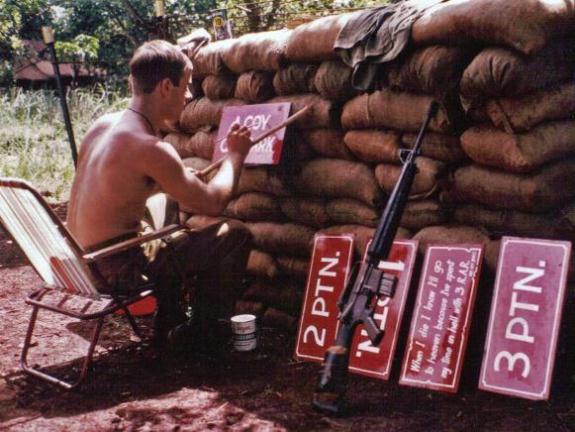 |
|
Pte. David "Johnno" Johnston. Rifleman, machine gunner, A Company 3RAR sign writer, Viet Nam 1968 |
|
 |
|
The likely route taken from Nui Dat to Ba Ria (Phuoc Le) on the morning that the infamous Tet Offensive broke out in Phuoc Tuy. The force was targeted by an ambush on the outskirts of Hoa Long en route to Ba Ria. |
|
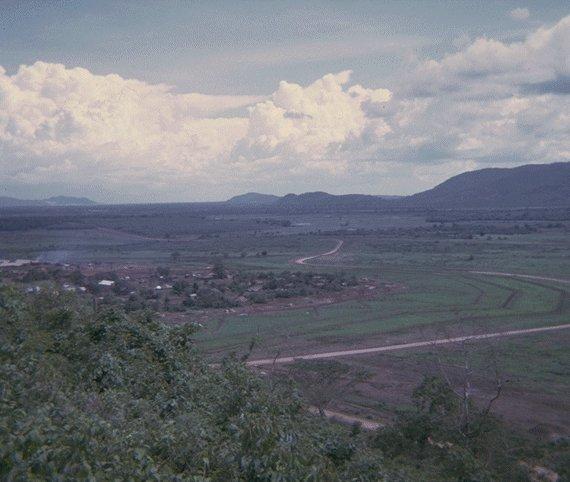 |
|
The view looking Route 2 from Nui Dat (SAS Hill), Phuoc Tuy Province, Viet Nam. Courtesy of 104 Sigs Battalion. |
|
8 RAR traveling the same route by APC between Hoa Long and Ba Ria some 2 years after the Tet Offensive. (www.taylor.id.au/official.htm) |
 |
 |
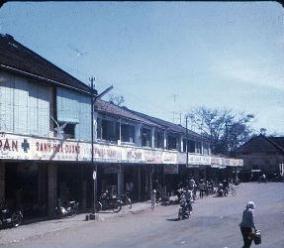 |
US Military post, Ba Ria. Photo courtesy of John Nulty RAE. |
Street scene in Ba Ria prior to Tet Offensive of 1968. Photo courtesy of John Nulty RAE. US Military |
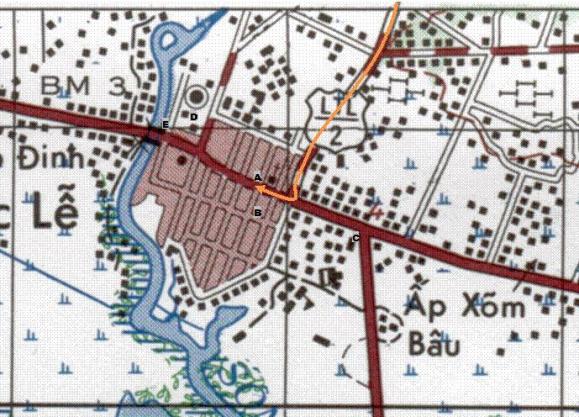 |
|
Ba Ria in 1968. Ba Ria in 1968. The orange arrow indicates the route taken into Ba Ria from Nui Dat down Route 2. The Song Dinh (River) is clearly seen to the left of the image, five significant locations are marked (A – E). A = Sector HQ; B = PRU House; C = Picture Theatre; D = Water Tower and Market Place; and E = Bridge over the Song Dinh. |
|
A group of Viet Cong lay in wait on the edge of the Hoa Long village, to the south of Nui Dat. They had set an ambush against the expected Australian force. They likely imagined that the Australians would come on foot as they were ill-prepared for armoured vehicles. These young Vietnamese fighters were quickly dispersed by the APC's mounted guns and the Australians moved on toward Ba Ria. As they reached the outskirts of Ba Ria close to 9 am they were immediately peppered with sniper fire. The APC's pushed straight through to the Sector HQ on the main road where the infantrymen deployed. As the soldiers sprung from the relative safety of the vehicles, they took up defensive positions in the roadside monsoon drains and behind walls while Major Howard went inside Sector HQ for briefing. The force immediately came under semi-automatic and rocket propelled grenade (RPG) fire from prepared positions inside nearby houses to which they responded with rifle and machine gun fire. Johnno remembers seeing the Vietnamese firing their AK47's, and that there were RPG's going everywhere. He took cover behind a 12‟ high wall at the front of Sector HQ and was shooting out with his SLR over the top of it at the vietcong who seemed to be everywhere. Because of the chaos he still isn't even sure if he hit anyone. This was the first time the newly arrived soldiers had been exposed to enemy fire, let alone the particularly aggressive nature of this fight. Ironically he had been trained at an elite level for jungle warfare, yet here Johnno found himself in the middle of the provincial capital of Phuoc Tuy receiving fire from dense buildings and about to undertake house to house combat. I asked him if he was scared but he said the same thing most veterans will tell you, that he was just doing his job. Training in basic fire and movement, sound weapon handling and good junior leadership would serve the troops well in the fights throughout the ensuing day, and beyond through the conflicts of the coming weeks and months. |
|
 |
Provincial Headquarters in Ba Ria 1968. Photo courtesy of Tom Menke, advisor with the provincial Intel and Recon Platoon from Oct 1967-Dec 1969. |
While initial reports from Sector HQ suggested that there were just two enemy platoons causing minor havoc in the village, the Australians found themselves facing at least two companies of local guerrillas, supported by Viet Cong. These were concentrated around the Sector HQ, Administration and Logistics Compound and a US Complex that housed the Provincial Reconnaissance Unit (PRU) and adjoining staff bungalows. Furthermore an estimated Viet Cong battalion (D445) was just north of the city, while two more companies were to the immediate south. In total an estimated 600 enemy troops were operating in the area but at that stage Sector HQ still believed only two enemy platoons were active. Major Howard became concerned about the security of an ammunition store at the Administration & Logistics compound in the north east of town, as well as for the US aid staff and a CIA officer who were holding out less than a kilometer away at the US Complex. This prompted him to obtain guides and disperse his force towards the areas of concern. Both the armoured vehicles and troops were vulnerable in the built up area, but some protection was afforded by moving mounted at speed rather than on foot. The APC's provided invaluable support to the infantry through increased safety during movement and also increased fire power in battle. As such, the APC and their crew may have significantly reduced what could have been a much higher casualty rate. Other heavy weaponry was discounted due to the potential risk to civilians in the built up area. Thus, the usual reaction force mortar platoon was left behind, as were the tanks and antitank weaponry. The 106mm recoilless rifles were thought to be too vulnerable because of the unprotected wheel base on the Land Rover's upon which they were mounted. As the troops dispersed, one section of APC's remained in protection of the Sector HQ. Lt Clarson's 3 platoon mounted APC's bound for the ammunition store at the Administration and Logistics Compound. Johnno boarded an armoured vehicle and headed out with Lt Fraser's 2 platoon and Howard's Company HQ to the stranded Americans at the US complex. En Route both Howard and Fraser recall seeing a Viet Cong dressed in civilian clothes sitting backward on a Lambretta firing at the leading APC with an AK47. This was particularly ineffectual and the leading APC section returned fire with their 50 caliber mounted heavy machine guns, easily killing the assailant and his rider. Once at the US Complex Johnno and the others dismounted and found that the Viet Cong fighters were already well entrenched in the surrounding houses. The Australians were immediately targeted by automatic and small arms fire that raked the streets. In this hectic and confused situation, one section of Lt Clarson's 3 platoon had also been accidentally taken to the US complex. The main 3 platoon group radioed through that they were OK on their own and as such decided that the segregated section would remain in support of 2 platoon and HQ. Howard received information from inside the US Complex Provincial Reconnaissance Unit (PRU) that three Americans were still possibly alive in a building about 20m to the east. Johnno was amongst those from 2 Platoon that was directed to clear and occupy the nearby houses on both sides of the road, including the one containing the Americans. Lt. Fraser reportedly asked Major Howard how to go about the task, to which he promptly responded, “Just use your grenades and go in after them!” As the group moved, Johnno saw some of his mate's go into the bottom of a house where they blasted fire upward through the ceiling to take out the Viet Cong on the second level. He remembers seeing an APC come under attack when it pulled into a narrow street where it was fired on from the surrounding houses. The aggressive Vietnamese soldiers threw grenades over the walls from one yard to another and fired RPG's into the surrounding roofs and trees spreading large amounts of debris for its scattering shrapnel effect. Johnno clearly remembers he and his mate Mick Maynard shooting what he thought was about six Viet Cong as they moved through the area, but when they later went back there was no sign of them. It was common for the Vietnamese to seal bleeding wounds before being carried off by their comrades for treatment. Hearing firing in one of the houses, Johnno‟s section ran into the courtyard where they came across two Viet Cong who they promptly shot as the Australians headed inside. Johnno recalls, “The Yanks were sitting around drinking whisky and smoking cigars as though they knew that they'd be rescued already”. With the Australian‟s inside the building, further Viet Cong fled from the rear and the Americans were moved out. Close to 10 am, the other sections moved to consolidate, when a grenade hit Pte White, while Cpl "Jock" Butchart and Pte Atkinson took shrapnel. At about that time Johnno remembers seeing Cpl "Jock" Strain take a bullet to the stomach being only metres away from him. The group returned fire and two Viet Cong were seen to fall. The Australian casualties and American agents were taken to the PRU house where they were prepared for evacuation. Meanwhile the Viet Cong took up and fired from positions in the trees and from the top of buildings. As the evacuation took place, Cpl Chapman was hit in the head by sniper fire from one of these elevated positions. Several soldiers returned fire and a sniper was seen to fall from the roof of a building. The detached 3 platoon section then cleared the house using grenades. Throughout the day, grenades proved useful in countering the enemy from behind stone walls around buildings. In particular the M79 grenade launcher was extremely effectual as the Australians fired them through the windows of enemy occupied houses. Following the action at the US Complex there were fears of a fresh attack on the Sector HQ from the east and 2 platoon were requested to move out to the picture theatre on the corner of Route 15. Meanwhile, the situation raged on for 3 platoon at the Administration and Logistic Compound who were engaging Viet Cong entrenched in bunkers with little result. It was decided that the detached section that had fought in support at the US Complex would be sent to reinforce the main 3 platoon body. Both the redeployment of 2 platoon and regrouping of 3 platoon were complete by 11am. While the action took place at the US Complex, the APC's back at Sector HQ had been engaging the enemy when an RPG hit 2Lt Tingley's Troop Command vehicle. Tingley's radios were rendered inoperable so Sgt Murphy took command of the group. Communication difficulties were frequent during the day but there was at least always some connection on various radio nets with the Sector HQ and either 1ATF or 3RAR back at Nui Dat. At the picture theatre Johnno remembers the contact easing off a little, The 2 platoon group encountered sporadic contact over the coming hours including sniper fire from the top of the theatre itself. At about 1pm, a request was received by 2Lt. Fraser to rescue CIA Agent Johnson, who remained trapped in his house back at the US complex. While the request had been received earlier heavy fire and unknown enemy strength at that location rendered the operation too risky. However, the APC's there were no longer under attack and it was felt that the situation had suitably stabilised. Important documents were also known to be at agent‟s house that needed to be destroyed to prevent them from falling into enemy hands. The benefit of returning to the US Complex at this stage outweighed the risks. At 1:10pm, 2Lt Fraser left the picture theatre with two sections of 2 platoon in as many armoured carriers. The remaining section stayed to patrol in the vicinity of the theatre to keep watch for any prospective attack. Johnno was one of this small group that remained behind and vividly remembers one point when things had quieted down, a local Vietnamese priest came out of his house opposite the theatre. The priest signalled to invite him inside for a cup of tea and although Johnno isn't sure why, he obliged and went inside where he found a sudden total serenity. The morning fighting could have been a distant memory thousands of miles away. After the shock of being exposed to such fierce battle for the first time, the generosity of this priest and his wife has never left him and stands as hazy surreal moment stamped forever in his memory. Overall, the Ba Ria residents appeared grateful for the Australian response during the day and on several occasions they pointed out Viet Cong locations. This may have been partly because the had been ejected from their homes by the Viet Cong, but the Australian efforts did seem to be appreciated. The medical orderly and stretcher-bearers bolstered the relationship by providing aid to many civilians during the day. Before the Australians had left the theatre a few dozen villagers who had been under attack were sheltered inside the safety of the picture theatre. Following the departure of the Australians, the communist soldiers are said to have massacred the civilians. |
|
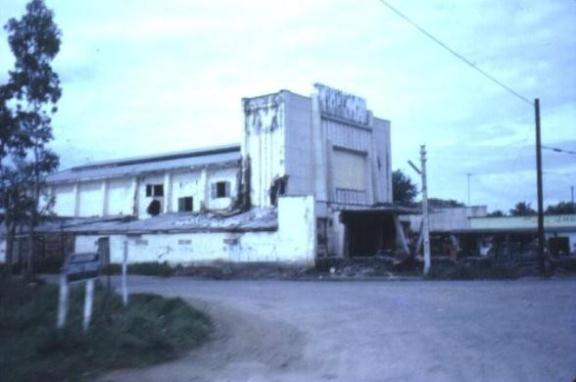 |
|
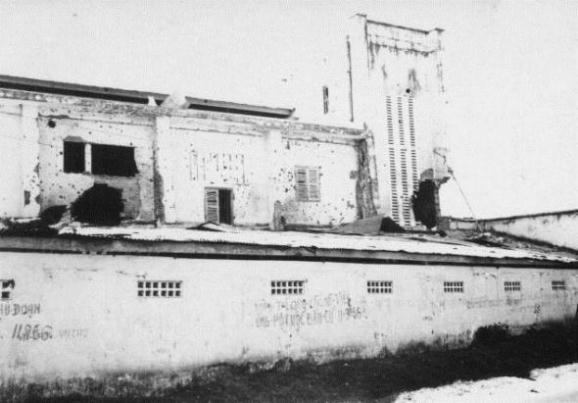 |
|
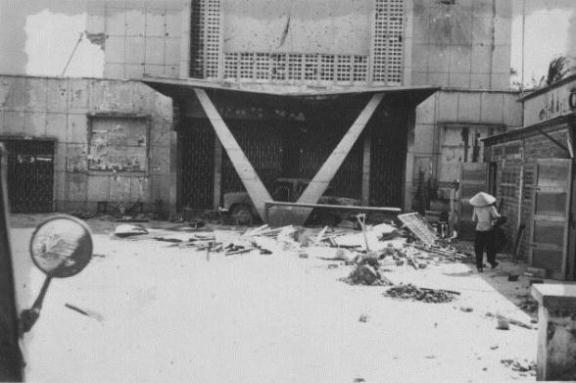 |
|
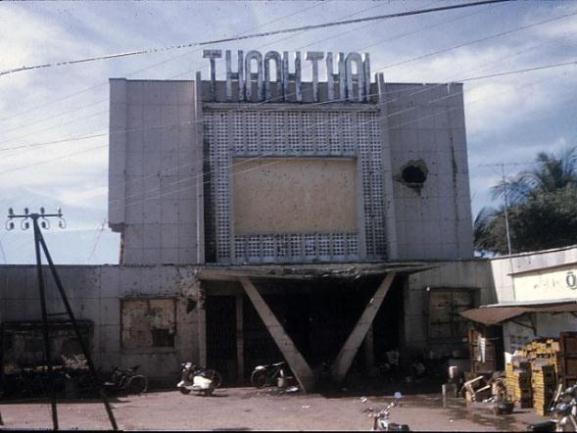 |
|
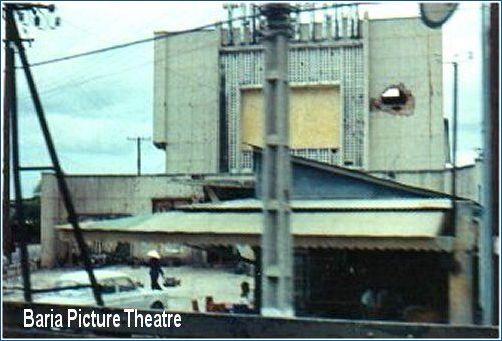 |
|
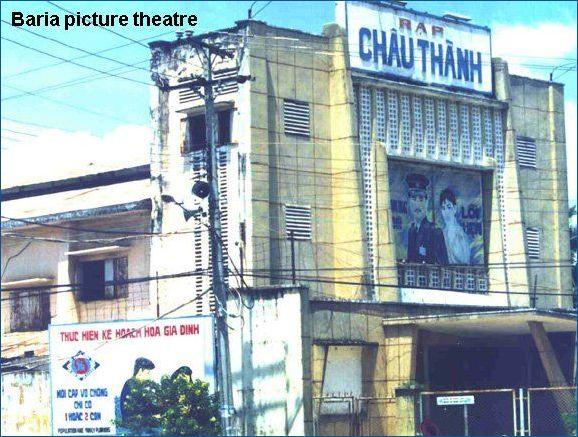 |
|
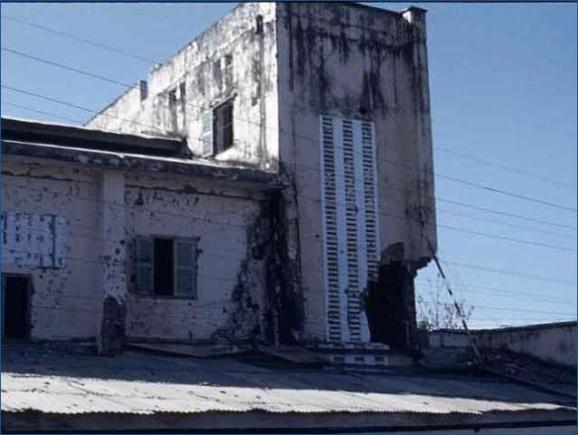 |
|
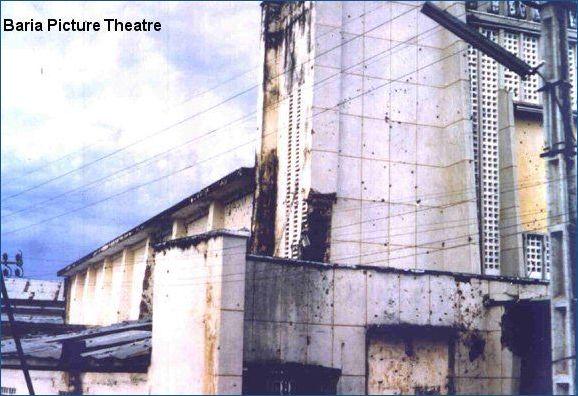 |
|
Ba Ria Picture Theatre with bullet and rocket damage sustained during the Tet Offensive. Possibly one of the most photographed structures in Phuoc Tuy by those who served there and came after them. Top two pictures courtesy of 104th Signals Squadron (http://www.au104.com/). Remainder courtesy Ern Marshalle (http://www.hotkey.net.au/~marshalle/). |
|
A different fate awaited 2Lt Fraser and the sections of 2 platoon en route to the US complex. The short journey went without incident before reaching the agent‟s house. Along the way they stopped to pick up two advisers who could aid in the recognition and destruction of any classified material. One was an American, Mr. Heidy, the other was Australian Warrant Officer Parello. The group then went on to the agent‟s house where they attended to the documents. As they prepared to evacuate Agent Johnson and his Chinese mercenary guard in an APC, a second vehicle moved out onto the road to cover their withdrawal and was hit in the engine by an RPG. The occupants scrambled back to the cover of the house as others engaged the Viet Cong. The other APC carrying Agent Johnson moved out in support but as it did Johnson poked his head out of the vehicle to fire his Swedish K submachine gun. Just as he did a well aimed RPG screamed in and took his head off. It subsequently entered the armoured vehicle where it fatally wounded Warrant Officer Parello. 2Lt Tingly and the forward observer's signaller were also wounded but managed to get back to the house where 2Lt Fraser's two, 2 platoon sections had barricaded themselves against the attack. As soon as the contact was reported, Howard‟s HQ team and the remaining section of APC's moved to provide support. Sporadic sniper fire and RPG's continued for hours against the men that remained bogged down inside the house. Because of the situation the recovery of the damaged APC's was seen as quite difficult. The Australians sent a request to the Army of the Republic of Viet Nam (ARVN) who were also fighting in the city for assistance to recover the vehicles. At about 3pm, shortly before 3RAR took over command of the action from 1ATF HQ, a company of the 52nd Ranger Battalion ARVN arrived at the scene and a plan was formulated to attempt to secure the vehicles. The ARVN company initially launched a successful assault that reached the vehicles, but they drew heavy fire and quickly retreated. Further attempts never got close enough, and all were eventually bogged down, the ARVN taking twelve casualties in the process. The ARVN company killed around 20 enemy soldiers during the afternoon, but it was thought that they claimed many more, including Viet Cong that were dead prior to their arrival. As a result of the ARVN's failed attempts to secure the APC's and the fact that 2Lt Fraser's sections were still pinned down, it was decided to call back 3 platoon from the Administration and Logistics compound. An air strike was also requested to clear the offending Viet Cong but it was not immediately available and the guys were told to wait it out. Earlier, 3 platoon had been engaging the Viet Cong who were entrenched in bunkers around the compound. Lt Clarson had launched a grenade attack against them and succeeded in clearing a few of the entrenchments. But he decided to call for an air strike to finish the difficult job. However before it arrived a mass of civilians appeared saying that Viet Cong were coming through their village to the north. The air strike was redirected accordingly. At about 1:30pm Johnno remembers three Phantoms come screaming past low overhead. They strafed and napalmed enemy in a creek bed near the 3 platoon location where the Viet Cong‟s charred remains were later found. Denis Hare of 104 Signal Platoon recalls watching the action from SAS Hill (Nui Dat) back at the 1ATF base and remembers feeling the heat from the strike some five to six kilometers away. A second air strike by three F100's hit Viet Cong soldiers in the village with rockets and 20mm machine guns. This action essentially lead to about 100 villagers being released who then reached the safety of a nearby ARVN compound. Just after 5pm 3 platoon had almost broken the bunkers when they took 16 rounds of mortar fire over a period of five minutes. No casualties occurred. As the battle for the bunkers swung decidedly in favor of 3 platoon, the enemy fled across paddy fields towards a patch of bamboo. 3 Platoon took down between 14 and 17 of them, and succeeded in taking one wounded prisoner to the Sector HQ for questioning. Having done their job and received the request for support, 3 platoon moved on to the US Complex in support of the pinned down 2 platoon men. 3 platoon reached the beleaguered troops at the US Complex just after 7pm, as the requested helicopter light fire team also arrived. The troops had waited for four hours for the air support, and when it arrived it would have been a very welcome sight. 2Lt Tingley had sufficiently recovered from his earlier injury and directed accurate mini-gun and rocket fire from the gun-ships onto the offending Viet Cong positions. 2Lt Tingley had also regained command of his troop carriers and organised the withdrawal of the two damaged vehicles that the ARVN company had earlier failed to secure. The air strike sufficiently subdued the Viet Cong and allowed the 2 platoon men to escape the house under protective fire from 3 platoon and the APC's. The damaged vehicles were towed out and the entire force across the town regrouped near the main road before heading west toward the river Song Dinh. The wounded needed to be taken for treatment but safe casualty evacuation points were difficult to find in the built up area. The group halted at the main market place 200m short of the river, which was thought to be a suitable site and a request was put in for the Dust Off. 3 platoon went ahead on foot down both sides of the road to the river while the remainder waited for the chopper to arrive. As they approached the bridge they came under friendly fire from local forces at an outpost across the river which prompted Lt Clarson to quickly identify his group. Ironically Major Howard had earlier requested the Sector HQ to warn the ARVN of their approach and he was assured it had been done. It obviously hadn't and the platoon was lucky not to receive any casualties in the process. By 8pm Lt Clarson's men had taken up a defensive position on the eastern side of the bridge where they could watch for any enemy attempting to cross from the outskirts of town to the west. Back at the market place, a UH-1 Iroquois "Huey" chopper arrived to evacuate the casualties. The pilot inspected the site from the air but reported that it was simply too difficult to land. Johnno remembers the site was too small and was criss-crossed with a chaotic maze of power lines, and the large town water tower protruded above it. Following this setback a request was made for a smaller Sioux "Possum" chopper. It arrived shortly after and the pilot, Capt John Coggan, ignored all the dangers to land three times to evacuate as many casualties. Johnno recalls watching him repeatedly come in under heavy enemy fire, weaving his way through the wires. He said that "if there was one hero that day, it was the pilot of that small chopper". Once the final casualty was evacuated, the group moved to join 3 platoon at the bridge and radioed in their position just after 9:30pm. The damaged APC's were towed onto the shabby narrow bridge to assist in blocking any potential enemy movement. A 50 percent stand-to was ordered, which gave much of the group a chance to recuperate and attend to the walking wounded. By this stage Johnno felt exhausted and pulled up a patch of ground beside the north-eastern corner of the bridge where he "slept" until morning. Night had well and truly fallen and although the impetus of the Viet Cong attack had slackened, illumination rounds were requested from the artillery back at Nui Dat. The Kiwi Gunners of 161 Battery RNZA pumped over 500 rounds out during the night permitting surveillance to the west across the river throughout the hours of darkness. The Aussie force had well and truly earned their rest after having fought hard and well through the day. The Viet Cong still remained in the area and were known to be in control of several houses in the city. To Major Howard's absolute dread, a Viet Cong bugler was heard through the darkness as whistles blew out from the opposite side of the bridge. This sounded what could have amounted to a potential battalion size attack. The Australians had spent the vast majority of their ammunition during the day's battles, which left them somewhat vulnerable to any further attacks. If there was one time in his career that Maj Howard thought his troops might have been done for it was when those sounds pierced the night air. However no attack eventuated and in retrospect Maj Howard felt that the placement of the APC's on the bridge may have deterred the enemy, who possibly mistook them for tanks. The situation remained static through the night except for occasional sniper fire and at one point when a number of RPG rounds hit nearby houses. Sporadic contact occurred elsewhere throughout the city but the Aussies saw the night out without serious incident. |
|
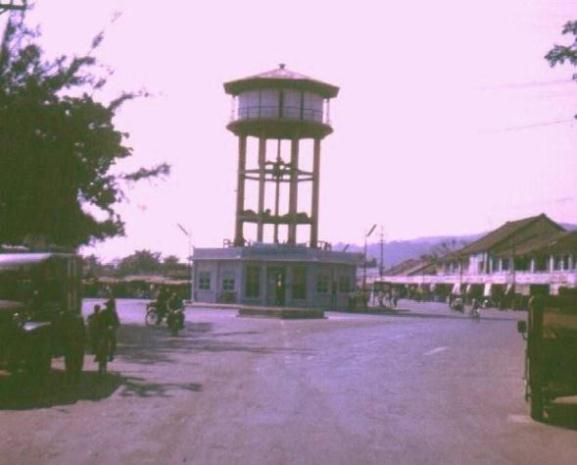 |
|
Ba Ria (Phuoc Le) water tower and town square. |
|
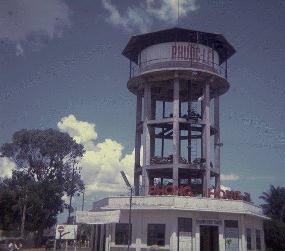 |
Left: Ba Ria (Phuoc Le) water tower near where John Coggan landed under fire to collect casualties during the Tet Offensive. Pictures courtesy 104 Signal Squadron (ww.au104.com/). |
Right: Bell 47G 3B1 Sioux "Possum" helicopter similar to that used by John Coggan during the Tet Offensive. Photo courtesy 161st Reconnaissance Flight (www.161recceflt.org.au/). |
 |
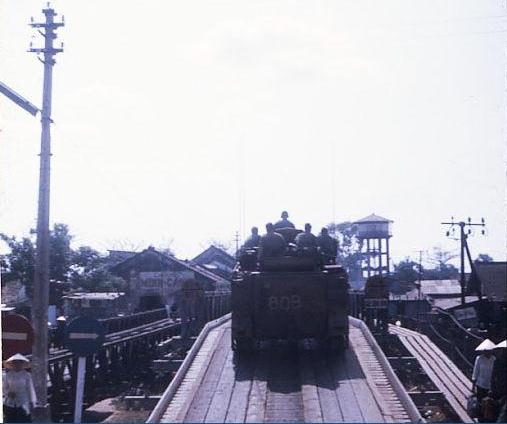 |
|
Approaching the bridge over the Song Dinh on APC (water tower visible in distance). |
|
 |
|
View from bridge over Song Dinh. This is the likely scene that faced Dave "Johnno" Johnston after waking up the morning following the battle. He recalls the villagers going about their business, washing and urinating in the river! Photos courtesy John Nulty, 3Tp, 1 Fd Sqdn RAE |
|
At first light Johnno recalls waking up beside the river and beholding the local villagers washing and urinating in the river. The force was spread out to cover the whole block and sentries were placed on every rooftop. Shortly before 8am they radioed through to Nui Dat that they were still guarding the bridge. They were requested to remain there for the time being by Sector HQ. They added a preliminary assessment that at least 30 enemy had been killed the previous day; nine by APC's, fourteen by 2 platoon and seven by 3 platoon, with possibly more unconfirmed. Normal civilian activity resumed for short periods throughout the morning, even though fighting was still underway elsewhere inside the city and to the west of the bridge. One sniper continued to fire at the Australians without success and sporadic contact was heard to the east of the A Company location. An ARVN outpost across the river was also seen to receive steady fire from a nearby building but the Australians now had their focus on their withdrawal from the town. A little earlier B Company was despatched from Nui Dat to assist in the extraction of the reaction force. They passed through Hoa Long shortly before 11am and as they approached Ba Ria down Route 52, they observed a group of civilians being mortared by the Viet Cong. The forward section came under semi-automatic fire as they attempted to aid the civilians and as they moved on towards the waiting reaction force. Contact continued as they checked and cleared houses along the way. Major Howard‟s troops also reported mortar fire nearby as they began to move from their overnight location. They headed to the Sector HQ, the scene of their opening battle the previous day, and awaited the arrival of B Company. By 3:30pm the damaged APC's had been hooked up and the two groups began making their way out of Ba Ria in the town trench, with A Company elements on foot in front of the mounted B Company group. An enemy force had moved into a position near the picture theatre at the junction of Routes 15 and 23 and Sector HQ requested the Australians to attend to the problem. The immediate response from the Task Force base was to the negative and reinforced that their sole task was to return back to the base. A request was made for a Sioux to provide cover for the return journey and by 3:45pm, the group was clear of the city and had begun to pick up speed. By 4:40pm the group had made it back through the gates at Nui Dat where they wound down for some well earned rest. |
|
 |
|
Photo of troops approaching Nui Dat Gates, courtesy of Ern Marshall http://www.hotkey.net.au/~marshalle/. |
|
| Epilogue to Tet in Ba Ria ‘68 | |
In the aftermath, the guys had a few days to settle back to normal duties at base. At 10am on the 6th of Feb, A Company were back test firing their weapons in the pits. D Company was deployed to Long Dien and B Company went to Ba Ria and Long Dien between the 3rd and the 6th February. There, they searched for and cleared the enemy who had retreated from Ba Ria and subsequently made attacks on Long Dien. B Company swept to Hoa Long on the 5th of Feb. Skirmishes and some heavy actions took place in surrounding villages, in particular D Company encountered heavy fighting. On the 8th of February, after a few days back at base, A Company headed out with D Company and the Anti-Tank Platoon to Hoa Long immediately to the south of Nui Dat. There, they uneventfully swept the houses for enemy. The search began just after 8:30 and a little over an hour later. D Company reported that they initially had some trouble with the map that they were given. Although the houses were accurate, the roads and map scale were confusing. As D Company approached one area the locals rang a bell warning of the approach of the Australian soldiers. The Anti-Tank Platoon saw 3 enemy dressed in black running east from their location just before 11am. However, they couldn't find them and suspected that they would encounter them on their search as they were heading east at the time. Large amounts of rice were noted in buildings indicating that a good crop had been had during the preceding season. The villagers were uneasy with the Australian activity, but A Company noted that they had quieted down by early afternoon. One section of A Company found an American Training Standard Operating Instructions manual inside a house at 2:30pm. The Anti-tank platoon recorded shots fired only 200 yards away from them just after 3pm but made no action. By this time A Company began making arrangements for transport home. In the meantime they located and detonated unexploded mortars before 5 vehicles arrived to transport them home. As there was not enough transport for both themselves and the Anti-tank group, two trips were made. At around the same time, B Company ran into heavy contact elsewhere and suffered serious consequences. Two men were killed including the commanding officer 2 platoon and five others were seriously wounded. That evening the whole of 3RAR was warned of an imminent move to the north, out of Phuoc Tuy to provide a blocking role against potential rocket attacks on major American bases in Bien Hoa Province. The uprising that was Tet subsided in most places and turned into an overwhelming military defeat for the communist forces across the whole of Viet Nam. The Free World Military Forces had curbed the planned sharp end to the war. None-the-less, it raised the profile of the war and the shock effect on the free world had dire consequences for the outcome of the war and social conscience. However, for Johnno and his mates it was proof of what they were made of. Johnno was surprised that his induction to fighting had taken place the way it had, but tells me that he was just doing what he was trained for. It was another day in the office. |
|
Luke Johnston |
|
 |
| The 3 RAR Internet site gratefully acknowledges the assistance of 101 design of Wollongong. www.101design.com.au |